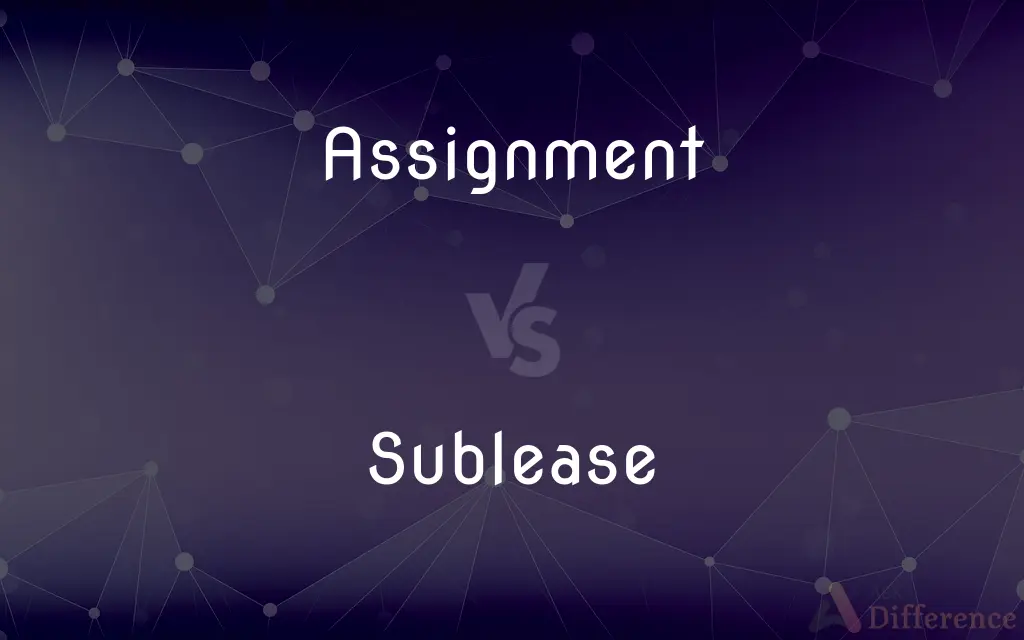Assignment vs. Sublease — What's the Difference?
By Tayyaba Rehman & Maham Liaqat — Published on April 10, 2024
Assignment involves transferring all lease rights to another, while subleasing involves leasing part of the lease term or space to a third party.

Difference Between Assignment and Sublease
Table of Contents
ADVERTISEMENT
Key Differences
An assignment of a lease is a complete transfer of the original tenant's rights under the lease to a new tenant, with the original tenant typically being released from all responsibilities. On the other hand, a sublease occurs when the original tenant leases part or all of the leased property to another party for a portion of the original lease term, without relinquishing the original lease.
In the case of an assignment, the new tenant directly assumes all of the original tenant's lease obligations towards the landlord. Whereas, in a sublease, the original tenant retains some degree of responsibility to the landlord and acts as an intermediary between the landlord and the sublessee.
Legally, assignments require the landlord's consent in most jurisdictions, as it involves a change in the primary party responsible for the lease. Subleases also typically require landlord approval, but the original lease agreement remains in force, and the original tenant maintains a legal relationship with the landlord.
Financially, an assignment effectively removes the original tenant from the financial obligations of the lease, transferring them to the new tenant. In contrast, the original tenant in a sublease situation remains liable for the rent and any damages, even if they are collecting rent from the sublessee.
Culturally, assignments are often used in commercial leases or long-term residential leases where a tenant needs to vacate permanently. Subleases are more common in residential contexts, especially among students or professionals who may need to relocate temporarily.
ADVERTISEMENT
Comparison Chart
Nature of Transfer
Complete transfer of lease rights
Partial transfer of lease rights
Legal Relationship
Direct relationship between new tenant and landlord
Original tenant remains intermediary
Consent Required
Yes, from landlord
Yes, usually from landlord
Financial Liability
Transferred to new tenant
Remains with original tenant
Common Use
Commercial leases, long-term residential leases
Temporary relocations, short-term needs
Compare with Definitions
Assignment
Transfers all obligations and rights from the original tenant to the new tenant.
After the assignment, she was no longer responsible for the monthly rent.
Sublease
Leasing part or all of a leased property by the original tenant to a third party.
She subleased her apartment for the summer while she was interning in another city.
Assignment
The complete transfer of a tenant's entire interest in a leased property to another party.
He opted for an assignment of his lease to move abroad without penalty.
Sublease
The original tenant retains a degree of responsibility to the landlord.
He remained liable for the rent, even though his sublessee was paying him monthly.
Assignment
The new tenant assumes all financial obligations.
The assignee now covers the rent and any damage fees.
Sublease
Requires landlord's approval, but the original lease terms stay intact.
The landlord allowed the sublease as long as the original tenant remained accountable.
Assignment
Typically requires the landlord's consent to change the tenant on the lease.
The landlord agreed to the assignment after reviewing the new tenant's application.
Sublease
Ideal for tenants needing temporary relief from their lease obligations.
Students frequently sublease their apartments during off-semester periods.
Assignment
Common in scenarios where the original tenant cannot fulfill the lease term.
Businesses often use assignment to transfer leases when relocating.
Sublease
Original tenant is still responsible for rent and damages.
Despite subleasing, she had to cover a shortfall when her sublessee paid late.
Assignment
(legal) A transfer of a right or benefit from one person to another.
The assignment of the lease has not been finalised yet.
Sublease
To sublet (property).
Assignment
(legal) A document that effects this transfer.
Once you receive the assignment in the post, be sure to sign it and send it back as soon as possible.
Sublease
To rent (property) under a sublease.
Assignment
An allotting or an appointment to a particular person or use; or for a particular time, as of a cause or causes in court.
Sublease
A lease of property granted by a lessee.
Assignment
A transfer of title or interest by writing, as of lease, bond, note, or bill of exchange; a transfer of the whole of some particular estate or interest in lands.
Sublease
(property law) A lease sublet by a tenant or lessee to a subtenant.
Assignment
(law) a transfer of property by deed of conveyance
Sublease
A lease by a tenant or lessee to another person; an underlease.
Sublease
Lease or rent all or part of (a leased or rented property) to another person;
We sublet our apartment over the summer
Common Curiosities
What happens if a sublessee fails to pay rent?
The original tenant remains responsible for the rent and any other lease obligations, despite subleasing.
Can a tenant sublease without the landlord's permission?
Generally, no. Most leases require the landlord's consent before a tenant can sublease the property.
Are subleases shorter than the original lease term?
Yes, subleases often cover a portion of the original lease term, tailored to the original tenant's temporary needs.
Can an assignment be reversed?
Once completed, an assignment is typically permanent, as it transfers all rights and obligations to the new tenant.
Can a landlord refuse an assignment?
Yes, landlords can refuse an assignment if it's allowed within the lease terms or if the prospective new tenant does not meet their criteria.
Is it easier to obtain approval for a sublease or an assignment?
It depends on the landlord's policies and the terms of the original lease; however, subleases may be more commonly approved due to the original tenant retaining some responsibility.
What legal documents are needed for a sublease?
A sublease agreement, typically approved by the landlord, outlining the terms under which the property is subleased.
What responsibilities does an assignee have?
The assignee takes on all responsibilities of the lease, including rent, maintenance, and adherence to lease terms.
Does an assignment release the original tenant from liability?
Yes, an assignment typically releases the original tenant from further liability under the lease, transferring it to the new tenant.
How does an assignment affect the landlord?
The landlord ends up with a new tenant who assumes all lease obligations, requiring vetting as with any new lease agreement.
What is the main difference between an assignment and a sublease?
An assignment transfers all rights and responsibilities to a new tenant, while a sublease transfers rights partially or temporarily without releasing the original tenant from obligations.
Is subleasing a good option for short-term housing needs?
Yes, subleasing is often used for short-term housing solutions, such as summer internships or study abroad semesters.
What are the benefits of subleasing?
Subleasing can offer flexibility for tenants who need to relocate temporarily without breaking their lease.
Can the original tenant profit from a sublease?
Depending on the terms of the sublease and the amount charged to the sublessee, the original tenant might profit, but this is often regulated by the lease terms and landlord's policies.
How does a sublease affect the original lease agreement?
The original lease remains in effect, with the original tenant maintaining their legal relationship with the landlord and ensuring the lease's terms are upheld by the sublessee.
Share Your Discovery

Previous Comparison
Jet Ski vs. Sea-Doo
Next Comparison
Android OS vs. Chrome OSAuthor Spotlight
Written by
Tayyaba RehmanTayyaba Rehman is a distinguished writer, currently serving as a primary contributor to askdifference.com. As a researcher in semantics and etymology, Tayyaba's passion for the complexity of languages and their distinctions has found a perfect home on the platform. Tayyaba delves into the intricacies of language, distinguishing between commonly confused words and phrases, thereby providing clarity for readers worldwide.
Co-written by
Maham Liaqat














































